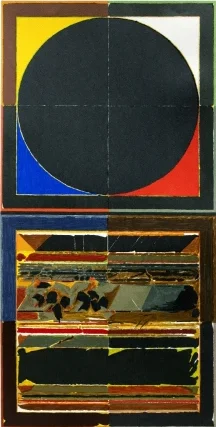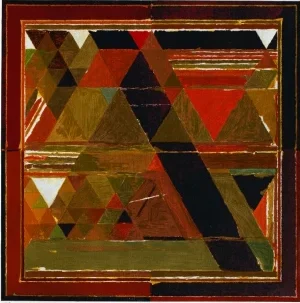About Sayed Haider Raza
His journey as an artist began in his early years, marked by a passion for drawing that eventually led him to pursue formal art education in India. After completing his studies at the Nagpur School of Art and the Sir J. J. School of Art in Mumbai, Raza embarked on a creative journey to France in 1950. When Raza moved to France, he was surrounded by creative artists in Paris. He mixed the modern art styles of Europe with his Indian background, which made his art evolve through the years. At first, he painted landscapes with emotions, but then he started making paintings that didn't look like real things, they were more about feelings and ideas. This change showed how he combined Indian spiritual ideas with what he learned in Europe.
Raza's artistic talent earned him recognition, including the prestigious Prix de la Critique in 1956, making him the first non-French artist to receive the honor. However, it was in the 1970s that Raza experienced a profound artistic awakening. Inspired by his travels to Indian cultural sites like Ajanta & Ellora and Varanasi, he deeply looked into his roots, embracing the concept of "Bindu" as a symbol of creation and existence. The Bindu became a central motif in Raza's work, representing a convergence of spiritual insights and artistic expression. Through geometric abstractions and meditative explorations, Raza wanted to express things that were hard to explain inviting people to think deeply and rise above ordinary thoughts. He received reputable Indian awards including the Padma Shri in 1981, Padma Bhushan in 2007, and Padma Vibhushan in 2013.
Raza's artistic talent earned him recognition, including the prestigious Prix de la Critique in 1956, making him the first non-French artist to receive the honor. However, it was in the 1970s that Raza experienced a profound artistic awakening. Inspired by his travels to Indian cultural sites like Ajanta & Ellora and Varanasi, he deeply looked into his roots, embracing the concept of "Bindu" as a symbol of creation and existence. The Bindu became a central motif in Raza's work, representing a convergence of spiritual insights and artistic expression. Through geometric abstractions and meditative explorations, Raza wanted to express things that were hard to explain inviting people to think deeply and rise above ordinary thoughts. He received reputable Indian awards including the Padma Shri in 1981, Padma Bhushan in 2007, and Padma Vibhushan in 2013.
Beyond his artistic pursuits, Raza remained committed to nurturing the next generation of artists and promoting art's role in society. He established the Raza Foundation in India, which continues to support young artists through various initiatives and awards. Additionally, the Raza Foundation in France preserves and promotes Raza's legacy, ensuring his artistic heritage endures for posterity.
In his later years, Raza came back to India and made New Delhi his home after his wife passed away. Over the years, Raza's passion for creating stayed strong. He kept making art that was meaningful and full of life. Raza's artistic journey came to an end on July 22, 2016, when he passed away at the age of 94. His final resting place in Mandla, Madhya Pradesh, beside his father's grave symbolized a homecoming. It was a perfect tribute to an artist whose life and work brought together people from different continents and cultures.
Sayed Haider Raza's artistic legacy transcends geographical boundaries, blending East and West, tradition, modernity, form, and spirit. His paintings are rich in meaning and spiritual depth, and still inspire and enchant people across the globe, reaffirming Raza's status in contemporary art. Raza tirelessly searched for artistic truth and strongly believed in cultural exchange. His bright vision enriched the world, leaving a lasting legacy that shows how powerful art can be.






















